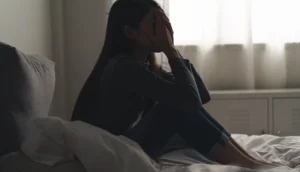Depression is more than just feeling down; it’s a serious mental health condition that affects your emotions, thoughts, and daily life. In this article, we’ll break down what is depression, its signs, its causes, and how it can be treated.
Key Takeaways
- Depression is characterized by persistent feelings of sadness and loss of interest, lasting for weeks or months, and requires proper diagnosis and treatment.
- Various types of depression exist, including major depressive disorder, persistent depressive disorder, and seasonal affective disorder, each with unique features and treatment needs.
- Effective treatment options for depression include psychotherapy, medication, and brain stimulation therapy, with self-care strategies contributing to overall management.
Defining Depression
Depression is more than just feeling sad or going through a rough patch. Depression is a common mental disorders that profoundly affects how a person feels, thinks, and handles daily activities. Unlike temporary sadness, depression involves persistent feelings of sadness and a withdrawal from activities that were once enjoyable, lasting for weeks or even months. This condition, also known as major depressive disorder or clinical depression, can significantly impair one’s ability to function and may lead some individuals to experience depression and panic disorder.
What sets depression apart from normal sadness is its severity and duration. While sadness is a natural response to life events such as loss or disappointment, depression is characterized by a persistent low mood and a lack of interest in activities that were once pleasurable. This distinction is crucial in understanding why depression is a serious mental health condition that requires attention and treatment.
Types of Depression
Depression is not a one-size-fits-all condition. There are several types of depression, each with its unique features. The most severe form is called major depressive disorder, which involves intense symptoms that interfere with daily life. This type of major depression can lead to significant distress and requires comprehensive treatment.
Another type is persistent depressive disorder, previously known as dysthymia. This condition involves milder depressive symptoms but lasts for at least two years, making it a chronic form of depression. Additionally, bipolar disorder is characterized by mood swings that include depressive episodes.
Special forms of depression include seasonal affective disorder, which occurs during the fall and winter months and improves with the arrival of spring. Atypical depression, on the other hand, allows for temporary mood improvements in response to positive events. Recognizing these different types aids in identifying the varied manifestations of depression and tailoring treatment.
Signs and Symptoms of Depression
Identifying the signs and symptoms of depression is the initial step towards seeking help. Emotionally, people with depression often experience overwhelming sadness, irritability, and intense irritability, along with a sense of apathy. In children and teenagers, these symptoms may present slightly differently but generally reflect similar feelings.
Physically, depression can manifest as fatigue, disrupted sleep patterns, and a lack of motivation. These physical symptoms often compound the emotional distress, making day-to-day functioning increasingly difficult, including difficulty concentrating. Behavioral changes, such as withdrawing from activities and responsibilities, are also common, especially for those experiencing trouble sleeping and physical problems.
The severity of these symptoms can vary widely. Some individuals may experience mild depression with low spirits, while others may face severe symptoms, including suicidal thoughts. Not everyone with depression will exhibit the same symptoms or severity, but recognizing these symptoms occur can prompt timely intervention and support.
Causes and Risk Factors
Depression is a complex condition with multiple causes and risk factors. Genetics play a significant role, with individuals who have a first-degree relative with depression being about three times more likely to develop the condition themselves. Biological, environmental, and psychological factors also contribute to the onset of depression.
Chronic health conditions, such as diabetes and cancer, can coexist with depression, often exacerbating the symptoms, especially in individuals with underlying medical conditions. Stressful events, such as losing a job or the death of a loved one, can trigger depressive episodes.
Additionally, certain medications and substance use, particularly alcohol, can increase the risk of develop depression and may also hinder efforts to prevent depression.
Diagnosing Depression
A thorough evaluation by a healthcare provider is necessary for diagnosing depression. Symptoms must be present nearly every day for at least two weeks, including either a depressed mood or losing interest in activities. This criterion helps differentiate between temporary sadness and clinical depression.
The diagnostic process includes:
- A comprehensive interview
- Personal and family history medical histories
- A physical exam
- Sometimes lab tests
These steps ensure that other potential causes of the other symptoms are ruled out, leading to an accurate diagnosis.
Factors such as the severity, frequency, and duration of symptoms, as well as their impact on daily activities, are also considered. If you think you may be experiencing depression, consulting a healthcare provider for a proper diagnosis is crucial.

Treatment Options for Depression
Treating depression effectively often requires a combination of approaches. Common treatment options include psychotherapy, medication, and brain stimulation therapy. These depression treatment options can be highly effective, with 70% to 90% of people responding well to them, especially when depression treated is part of the overall strategy.
For milder forms of depression, starting with psychotherapy is often recommended. More severe cases may require medication or brain stimulation therapy. Understanding these treatment options can help individuals make informed decisions about their care.
Medication
Antidepressant medication is a cornerstone in treating depression. These medications work by altering brain chemistry, with selective serotonin reuptake inhibitors (SSRIs) often being the first choice due to their safety and fewer side effects. Patients may start to see improvements within the first week or two, but full benefits usually take two to three months.
Ongoing communication with a healthcare provider is crucial. If there is little to no improvement after several weeks, adjustments in dosage or a switch to a different medication may be necessary. Continuing antidepressants for at least six months after symptoms improve is generally recommended to prevent relapse.
Psychotherapy
Psychotherapy is an effective treatment for depression. Cognitive behavioral therapy (CBT) has shown high effectiveness. CBT helps individuals recognize and correct unhealthy thinking patterns that contribute to their depressive symptoms. Interpersonal therapy is another form that focuses on improving relationships and communication skills.
Group therapy also offers significant benefits by providing mutual support and shared learning experiences. Significant improvements are usually observed after about 10 to 15 sessions of psychotherapy, including talk therapy. This timeframe typically results in positive changes in a person’s mental health. This treatment is particularly beneficial for those who prefer a non-medication approach to managing their depression.
Brain Stimulation Therapy
Brain stimulation therapy is often considered for severe depression cases that do not respond to medication or psychotherapy. Electroconvulsive Therapy (ECT) is one of the most commonly used types. Another frequently utilized type is repetitive transcranial magnetic stimulation (rTMS). These therapies involve activating or inhibiting the brain using electrical or magnetic waves.
ECT is a medical treatment that induces a brief seizure to help alleviate severe depression and is typically administered two to three times a week. The process is managed by a healthcare team, including a psychiatrist, anesthesiologist, and nurse or physician assistant.
These therapies are vital for those who have not found relief through other treatments.
Self-Care and Coping Strategies
Self-care and coping strategies are essential in managing depression. Lifestyle changes that can significantly help include:
- Regular physical activity
- A balanced diet
- Quality sleep
- Avoiding alcohol
Engaging in daily physical activities like walking can boost mood and overall health.
Maintaining a healthy lifestyle involves:
- Maintaining a healthy diet and proper hydration to improve focus and energy levels.
- Establishing a sleep routine and reducing screen time before bed to enhance sleep quality.
- Engaging in relaxing activities like meditation and mindfulness to support mental well-being.
How Back Bay Mental Health Can Help
Back Bay Mental Health offers personalized treatment plans tailored to the unique needs of each patient. Located conveniently in Boston, Massachusetts, the facility is easily accessible via public transportation. This accessibility ensures that clients from different parts of the city can receive the care they need.
The facility provides therapy and medication management services to help individuals struggling with depression. Most major health insurance plans cover the Intensive Outpatient Program, and assistance is available for verifying depression benefit.
The comprehensive approach at Back Bay Mental Health ensures that each patient receives the best possible care.
Depression is a multifaceted condition that affects millions of people worldwide. Understanding its various forms, recognizing the signs and symptoms, and knowing the causes and risk factors are crucial steps towards effective management. Treatment options like medication, psychotherapy, and brain stimulation therapy offer hope and relief for many individuals.
If you or someone you know is experiencing depression, seeking professional help is vital. By addressing depression with the appropriate care and support, it is possible to reclaim a fulfilling and joyful life. Remember, you are not alone, and help is available.
Frequently Asked Questions
What is the difference between sadness and depression?
Sadness is a natural reaction to life’s difficulties, whereas depression is a serious mental health condition characterized by persistent feelings that significantly impair daily life. Understanding this distinction is crucial for proper support and treatment.
How is depression diagnosed?
Depression is diagnosed through a thorough evaluation by a healthcare provider, which includes interviews, medical history, and potentially lab tests to rule out other conditions. Seeking professional help is crucial for an accurate diagnosis.
What are the common types of depression?
Common types of depression include major depressive disorder, persistent depressive disorder, bipolar disorder, seasonal affective disorder, and atypical depression. Understanding these types can help in seeking appropriate treatment and support.
What treatment options are available for depression?
Effective treatment options for depression include medication, psychotherapy, and brain stimulation therapy, tailored to the individual’s specific needs and the severity of their condition. Choosing the right approach can significantly improve mental well-being.
How can lifestyle changes help manage depression?
Incorporating regular exercise, maintaining a balanced diet, ensuring quality sleep, and participating in relaxing activities can effectively alleviate depressive symptoms and enhance your mental well-being. Prioritizing these lifestyle changes is crucial for managing depression.




